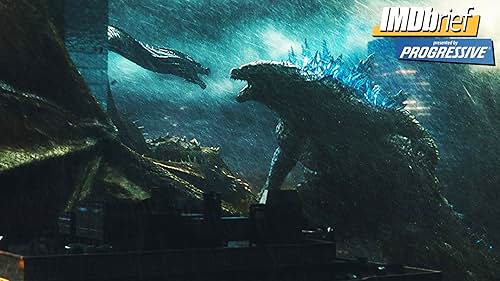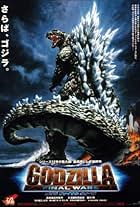NOTE IMDb
7,6/10
42 k
MA NOTE
Les essais d'armes nucléaires américains ont engendré la création d'une créature qui ressemble à un dinosaure, que rien ne semble pouvoir arrêter.Les essais d'armes nucléaires américains ont engendré la création d'une créature qui ressemble à un dinosaure, que rien ne semble pouvoir arrêter.Les essais d'armes nucléaires américains ont engendré la création d'une créature qui ressemble à un dinosaure, que rien ne semble pouvoir arrêter.
- Récompenses
- 4 victoires et 2 nominations au total
Kokuten Kôdô
- The Old Fisherman
- (as Kuninori Kôdô)
Histoire
Le saviez-vous
- AnecdotesAn often-repeated myth is that the productions of both this film and Les 7 Samouraïs (1954) nearly drove Toho into bankruptcy. This neglects to mention a third Toho film made that year, La Légende de Musashi (1954). All three of them were the most expensive Japanese films made up to that point and big financial risks for Toho. However, there is little evidence to suggest that Toho was ever at risk for bankruptcy. Toho released a total of 68 feature films that year, the most successful of which were "Seven Samurai", "Samurai I: Musashi Miyamoto", and "Godzilla", in that order.
- GaffesSeveral characters in the film, including Dr. Yamane, Japan's leading paleontologist, insist that the Jurassic Period was 2 million years ago. This is off by 143.5 million years.
- Citations
[last lines]
Dr. Kyohei Yamane: I can't believe that Godzilla was the last of his species. If nuclear testing continues, then someday, somewhere in the world, another Godzilla may appear.
- Versions alternativesIn the scene where Godzilla destroys the train, shots of terrified people watching were cut from the U.S. version of the film.
- ConnexionsEdited into Le Retour de Godzilla (1955)
- Bandes originalesPrayer for Peace
(uncredited)
Performed by students of the Toho High School of Music
Lyrics by Shigeru Kayama
Composed by Akira Ifukube
Commentaire à la une
Trying to convince somebody that isn't wholly invested in cinema, or somebody simply not willing to learn about the culture, that the first Godzilla film was actually a film littered with commentary and played nothing like the idea we all have in our heads about the towering monster is a daunting and almost thankless task in itself. Once you grasp the idea of a postwar Japan that was left demilitarized and financially and structurally battered, fearful of invaders, nuclear repercussions, and the country's future in terms of basic economic prosperity, the original, 1954 Japanese film (known as Gojira in Japanese) becomes a film ripe for thoughtful dissection and analysis by just your average cinephile or history buff.
Little needs to be explained in the way of the film's story, I feel, but the basic idea concerns the awakening of a towering behemoth thanks to prolific nuclear testing in the Pacific Ocean. The Japanese are petrified of the destruction possible with this creature lurking around, find their government is content on hiding and obscuring facts related to the issue, and see a dissenting country in the mix of deciding what to do with the monster. While a good majority of the people, understandably, want this monster extinct and destroyed as soon as possible, Dr. Yamane Emiko (Momoko Kōchi) finds the possibility for research and analysis on Godzilla invaluable and has the ambition to try and capture him alive. Dr. Emiko is in the minority on this view, but he sees the long-term value in the creature, while the townspeople, acting on impulse and responding to an immediate conception of fear, want nothing to do with the creature.
This ignites an idea brought on by classic Universal monster movies of the 1930's and 1940's about humans' role in these man-made disasters, or whether or not humans have the responsibility to "play God" in any way. This idea, in conjunction with relativistic looks at the Japanese mindset in the 1940's and 1950's, after the repercussions of World War II, the basic elements of human fear, and what Godzilla metaphorically represents, are all relative in analyzing this particular piece, and it may indeed be the only franchise where the first film is looked at and critiqued in an entirely different light than its successors.
Following the boom of the Japanese film industry in the 1950's and 1960's, American activities such as golf were beginning to become prominent in Japan, along with the ubiquity of home Television sets, which saw exponential sales from a few thousands to two million during the mid to late 1960's. As a result, Japan's successful film industry became short-lived, as less and less people flocked out to the theaters due to the lack of popularity of the establishments comparative to the United States. The company that released Gojira, Toho and its director Ishirō Honda, began catering to the lowest common-denominator, not filling their follow-up efforts to Godzilla with thought-provoking commentary on Japanese culture and topical events, but instead, loading them with the kind of cheesiness and glitz expected to attract young children or a late-night audience. The Godzilla films became more concerned with the sounds-and-lights aesthetic, ridiculous and often ludicrous monsters that were totally geared towards selling action figures, and a line of comic books and video games to license the everlasting hell out of Godzilla name.
This kind of franchise and international ubiquity obscured the original film not only for its datedness but made its justifications for social commentary laughable to those uninformed about Japanese culture at the time . This is one of the many things licensing does to hurt a brand or product in the long-term sense, for it alienates consumers because they can't seem to escape it no matter which way they turn, but the reasons for the greatness of the original product become lessened or forgotten due to the constant influx of new material related to the original work.
Gojira may find itself crude in parts, with its assembly of miniatures optimistically passing off as a rogue monstrosity devastating a large community, or its evident aspects showcasing overacting, but it's nonetheless enjoyable on an entertainment level and thoughtful on a commentary-level. This is one of the few films that can be so relevant and topical while playing one of the most simplistic but effective instrumental tracks, and that in its own right is uncommonly beautiful.
Starring: Akira Takarada, Momoko Kōchi, Akihiko Hirata, and Takashi Shimura. Directed by: Ishirō Honda.
Little needs to be explained in the way of the film's story, I feel, but the basic idea concerns the awakening of a towering behemoth thanks to prolific nuclear testing in the Pacific Ocean. The Japanese are petrified of the destruction possible with this creature lurking around, find their government is content on hiding and obscuring facts related to the issue, and see a dissenting country in the mix of deciding what to do with the monster. While a good majority of the people, understandably, want this monster extinct and destroyed as soon as possible, Dr. Yamane Emiko (Momoko Kōchi) finds the possibility for research and analysis on Godzilla invaluable and has the ambition to try and capture him alive. Dr. Emiko is in the minority on this view, but he sees the long-term value in the creature, while the townspeople, acting on impulse and responding to an immediate conception of fear, want nothing to do with the creature.
This ignites an idea brought on by classic Universal monster movies of the 1930's and 1940's about humans' role in these man-made disasters, or whether or not humans have the responsibility to "play God" in any way. This idea, in conjunction with relativistic looks at the Japanese mindset in the 1940's and 1950's, after the repercussions of World War II, the basic elements of human fear, and what Godzilla metaphorically represents, are all relative in analyzing this particular piece, and it may indeed be the only franchise where the first film is looked at and critiqued in an entirely different light than its successors.
Following the boom of the Japanese film industry in the 1950's and 1960's, American activities such as golf were beginning to become prominent in Japan, along with the ubiquity of home Television sets, which saw exponential sales from a few thousands to two million during the mid to late 1960's. As a result, Japan's successful film industry became short-lived, as less and less people flocked out to the theaters due to the lack of popularity of the establishments comparative to the United States. The company that released Gojira, Toho and its director Ishirō Honda, began catering to the lowest common-denominator, not filling their follow-up efforts to Godzilla with thought-provoking commentary on Japanese culture and topical events, but instead, loading them with the kind of cheesiness and glitz expected to attract young children or a late-night audience. The Godzilla films became more concerned with the sounds-and-lights aesthetic, ridiculous and often ludicrous monsters that were totally geared towards selling action figures, and a line of comic books and video games to license the everlasting hell out of Godzilla name.
This kind of franchise and international ubiquity obscured the original film not only for its datedness but made its justifications for social commentary laughable to those uninformed about Japanese culture at the time . This is one of the many things licensing does to hurt a brand or product in the long-term sense, for it alienates consumers because they can't seem to escape it no matter which way they turn, but the reasons for the greatness of the original product become lessened or forgotten due to the constant influx of new material related to the original work.
Gojira may find itself crude in parts, with its assembly of miniatures optimistically passing off as a rogue monstrosity devastating a large community, or its evident aspects showcasing overacting, but it's nonetheless enjoyable on an entertainment level and thoughtful on a commentary-level. This is one of the few films that can be so relevant and topical while playing one of the most simplistic but effective instrumental tracks, and that in its own right is uncommonly beautiful.
Starring: Akira Takarada, Momoko Kōchi, Akihiko Hirata, and Takashi Shimura. Directed by: Ishirō Honda.
- StevePulaski
- 16 oct. 2014
- Permalien
Meilleurs choix
Connectez-vous pour évaluer et suivre la liste de favoris afin de recevoir des recommandations personnalisées
Détails
- Date de sortie
- Pays d’origine
- Langues
- Aussi connu sous le nom de
- Japón bajo el terror del monstruo
- Lieux de tournage
- Société de production
- Voir plus de crédits d'entreprise sur IMDbPro
Box-office
- Budget
- 175 000 $US (estimé)
- Montant brut aux États-Unis et au Canada
- 562 711 $US
- Week-end de sortie aux États-Unis et au Canada
- 38 030 $US
- 9 mai 2004
- Montant brut mondial
- 590 389 $US
- Durée1 heure 36 minutes
- Couleur
- Rapport de forme
- 1.37 : 1
Contribuer à cette page
Suggérer une modification ou ajouter du contenu manquant


































